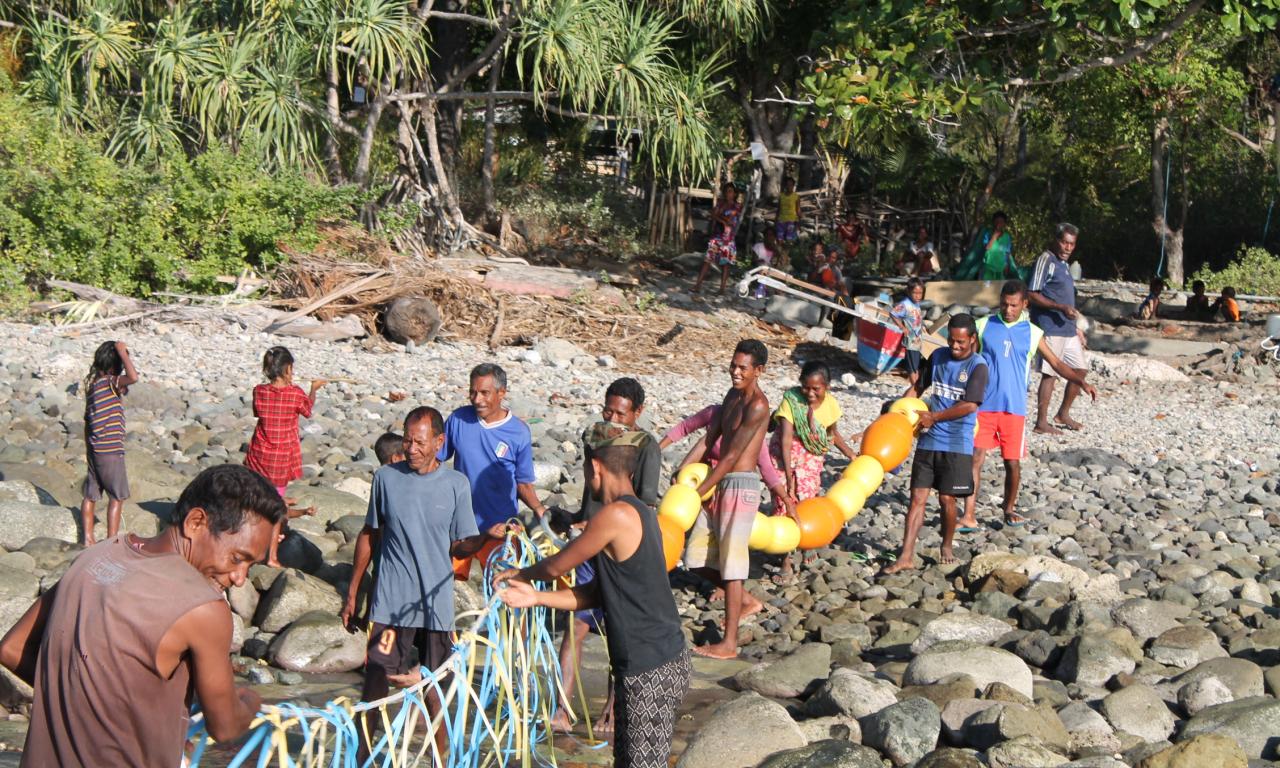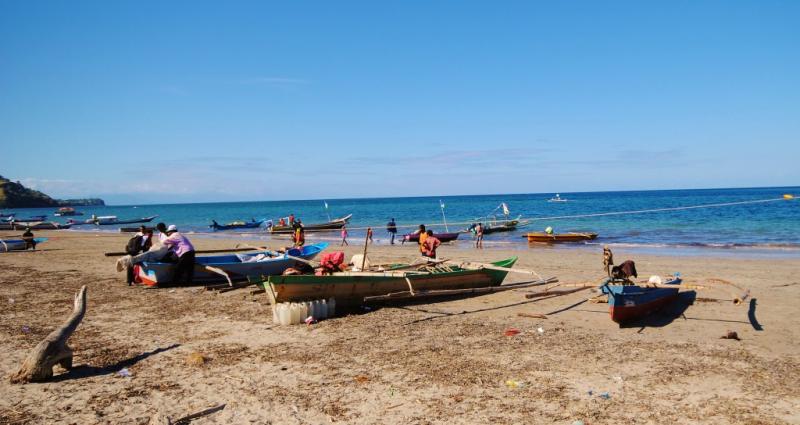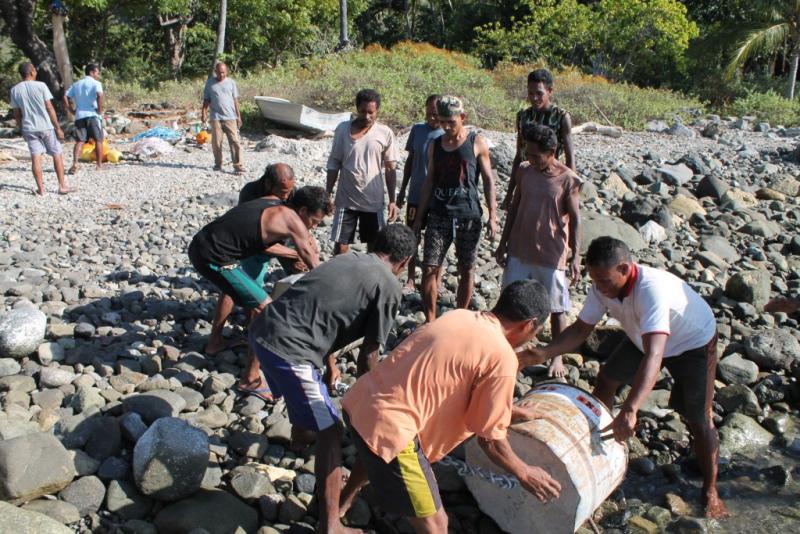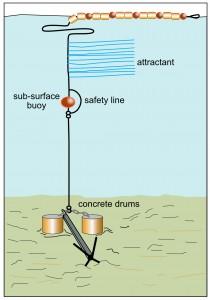
Nearshore fish aggregating devices are a relatively simple technology. Despite this, finding a FAD design suited to the marine conditions of the half-island nation and accessible to artisanal fishers has taken many years of research by WorldFish and the Ministry of Agriculture and Fisheries in Timor-Leste.
Recommended publications
- Optimising the use of nearshore fish aggregating devices for food security in the Pacific Islands
- The contribution of nearshore fish aggregating devices (FADs) to food security and livelihoods in Solomon Islands
In Timor-Leste, the recent introduction of nearshore fish aggregating (FAD) devices by WorldFish and the Ministry of Agriculture and Fisheries (MAF) is helping small-scale fishers catch more oceanic fish, which is an important source of food, nutrition and income for coastal communities.
But, despite being a relatively simple technology, finding a nearshore FAD design suited to the marine conditions of the half-island nation and accessible to artisanal fishers has taken many years of research by WorldFish and MAF.
FADs are man-made objects used to attract oceanic fish such as tunas, mackerel and scads. Offshore FADs are the large drifting oceanic platforms that have drawn criticism from conservation NGOs as they massively increase the fishing power of industrial tuna fleets. Nearshore FADs, in contrast, are relatively small and anchored to the sea floor near the coast. Fishers use methods such as troll-line fishing, line fishing and spear fishing to catch fish around the nearshore FADs.
The purpose of nearshore FADs, which are increasingly being used in the Pacific region, is to provide coastal communities with easy access to oceanic fish. This access is much needed in Timor-Leste, where the majority of fishers are small-scale and use outrigger canoes and small motor boats. Limited by the distance they can travel, these fishers target nearshore, fringing reef systems, which has been a contributory factor to the decline of reef resources.

But the unique marine conditions of Timor-Leste present some challenges to keeping nearshore FADs intact and in place. The waters surrounding the island of Atauro to the north of the capital Dili extend quickly to great depths of up to 3000 m. And these coastal waters experience very strong currents – currents that also link the Pacific and the Indian oceans.
It was these strong currents that resulted in the first nearshore FADs introduced in Timor-Leste, by Indonesian artisanal fishers in the 1990s and made from ropes and a plastic drum, to fall apart quickly.
To find a longer-lasting solution, coastal fisheries staff from the Pacific Community (SPC) came to Timor-Leste in 2012 to work with MAF and WorldFish on deploying a new design of coastal FAD that has worked well elsewhere in the Pacific. While much was learned, the anchor design, consisting of two heavy hook-like ‘grapnel’ anchors, proved inadequate for the conditions found in Timor-Leste.

In 2013, the ACIAR-funded Exploring options to improve livelihoods and resources management in Timor-Leste coastal communities project allowed WorldFish and partners to look further into improved FAD systems. Thinking a suitable FAD design had been found, the project team, including representatives of MAF, deployed eight FADs between 2014 and 2015 around Batugade and Beacou on the north coast of the mainland and Adara village on Atauro Island.
However, testing revealed new problems. The anchor – a pair of two cemented half drums – was still not deemed sufficient to handle the strong currents and flexibility in the rigging design needed to be improved by the addition of extra swivels to ensure ropes did not become twisted.

In 2016, the project improved the existing design by including a sub-surface buoy at a depth of 20 m where it could be serviced by a diver, and adding a safety line around this buoy so the FAD would not be lost if the rope failed at this point prior to servicing. A total of three swivels were included in the unit and a grappling hook added to link the two cemented half-drums via a three-meter galvanized chain. This design was then replicated and adopted nationwide, in Vemasse (Baucau), Aderai (Viqueque), most of Atauro island, and Beacou and its nearby village of Sulilaran (Bobonaro).
To date, the new design is proving to withstand the strong currents. Now, research is underway as part of the CGIAR Research Program on Fish to evaluate the benefits that nearby communities derive from nearshore FADs.
Research shows that FADs can enable small-scale fishers to profit from new and more productive fishing grounds, meaning they spend less time hunting for fish and use less effort to catch the same amount of fish. FADs also allow fishers to be closer to shore which is helping to improve safety.
The most significant benefits to-date have been observed in Adara, where WorldFish introduced a nearshore FAD in 2014. Before the FAD, local fishers reported that they travelled as far as the Indonesian island of Wetar – a dangerous and expensive undertaking due to the distance and cost of fuel, food and fishing permits. Now, with the introduction of FADs, many say they do not travel that far anymore and that their income has increased.
In addition, WorldFish research is focusing on how FADs may work alongside community-based and traditional resource management systems such as tara bandu. These management approaches help to improve the sustainability of fish catches that, in part, can be achieved by reducing fishing pressure placed on declining reef resources.
Timor-Leste faces high rates of food insecurity and unemployment. These early successes suggest that the introduction of FADs and improvements in FAD design can help bring real change to coastal fishing communities. Moving forward, implementing good monitoring and management systems will be crucial to ensure the sustainability of FAD-based fisheries.
